There are wine varietals that you find to be most common, when you plunk down at a restaurant, open the menu, and turn to the wine selections. The normal, everyday suspects that grow anywhere and whose names just roll off the tongue—Cabernet Sauvignon, Pinot Noir, Chardonnay, Riesling, and Pinot Grigio. Sure, there are differences by regions, and even differences by producer. But do you get bored by the same five or six kinds, regardless of where they are from? Is the world only in eight-bit color to you? There are more than 10,000 grapes in the world that have successfully fermented into wine, most even produced commercially. This week at City Vino we are exploring the obscure varietals.
When we think of sparkling wine, our thoughts focus on a coupe, flute or tulip glass, partially filled with a light to medium-gold wine, with bubbles rising in a stream to the top. Or perhaps, you think of a pink bubbly. City Vino is here to tell you that All That Sparkles is Not Gold (or Pink). Red sparkling wine exists, and has its place in your glass and on the table.
Argentina is responsible for 45 percent of the production of wine in South America, and is the sixth-top wine producing country in the world. As of 2018, the country has over 489,000 acres of vineyards.
Most people are familiar with Argentinian wines made from the Malbec grape. Did you know that the second-most-planted grape in Argentina is Bonarda? The grape was brought to Argentina in the 19th century and was thought to be the Bonarda del Piedmont grape, from Italy. DNA studies in 2009 changed that thought, when it was discovered that the Bonarda in Argentina is actually the Corbeau Noir—a grape from Savoie in the French Alps. The name Argentina was placed behind the name Bonarda, to differentiate it from the Italian variety of the same name. Other synonyms for Bonarda, in addition to Corbeau Noir, include Charbono and Douce Noir.




